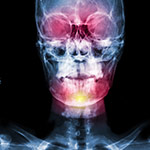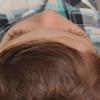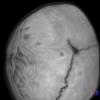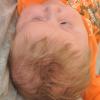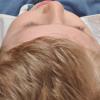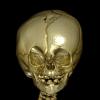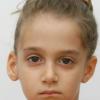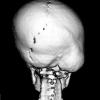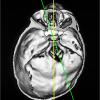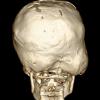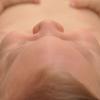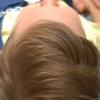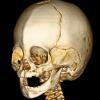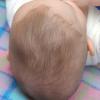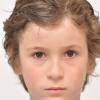NON SYNDROMIC (PLAIN) CRANIOSYSNOSTOSES
CRANIAL SUTURES AND PREMATURE CRANIOSYNOSTOSIS
Craniosynostosis is called the premature conjunction of two or more skull bones.The infant skull consists of bones which aren’t still joined together but are held by flexible joints which are called cranial sutures. Because at the early stages of life, the brain has a very intense growth, the bones, yielding to the pressure of the developing brain are removed from one another thereby permitting the normal development of the brain and skull. When the growth of the brain stops, the cranial sutures lose their functional significance and have no reason to exist anymore, so they close and the bones are joined together.
Premature synostosis, i.e. the premature connection of bones, prevents the normal development of the skull and brain and causes morphological (changes in normal head shape), functional, and developmental problems in children. If a suture between the two bones closes prematurely, then the skull cannot grow normally and bones which still have open sutures, will be developed more compensatory as not to limit the development of brain volume. This has as a result, the further deformed head growth. The premature synostosis of each suture creates a characteristic deformity (see below).
There are four general categories of non syndromic prematue synostosis:
PLAGIOCEPHALY
The term "plagiocephaly" is a broad term in order to describe the asymmetric formation of the skull, and is divided into two groups: the frontal and occipital plagiocephaly.
FRONTAL PLAGIOCEPHALY
The ‘frontal plagiocephaly’ is characterized by widening and asymmetry of the face due to premature closure (early synostosis) of the left or right side of the coronary suture.
The appearance is characteristic:
- On the side, where the problem exists, the forehead (brow) is wide (flat) or even concave.
- The nasal root is drawn to the side of the problem.
- The orbit is raised in relation with the orbit of the opposite side.
- The eyebrow is usually at a higher position.
- The ear is also in a more forward position.
- On the opposite side, the forehead (brow) is more visible, a phenomenon that is caused by the pressure that the brain exerts in an effort to provide the necessary space for its development
Diagnosis in the first months of infancy is absolutely necessary, because the confronting of the synostotic frontal plagiocephaly is always surgical and should be ideally done from the sixth to the twelfth month, in order to ensure the maximum benefit. The malformation which is considered unimportant by many parents, actually develops into a serious problem, because as time passes it deteriorates. In older age, the surgical repair is significantly more difficult.The restoration of the frontal plagiocephaly is performed by a surgical team that is specialized in craniofacial problems. In certain cases, the craniofacial / plastic surgeon and the neurosurgeon cooperate.
During the surgery, the malformative area of the forehead and orbital cavities are removed and with various manipulations, the physiological shape of the bone area, which is the upper portion of the orbital cavities, is assigned. This is followed by the displacement of bone fragments in order to create a new and symmetrical forehead. The stay of the patient in the Intensive Care Unit for 24 hours after surgery is essential in order for the optimal resuscitation to be ensured and the total hospital stay is usually no more than 5-7 days.
OCCIPITAL PLAGIOCEPHALY
The occipital plagiocephaly is characterized by asymmetry and widening of the back section of the head (cerebrooccipital region). Most cases of occipital plagiocephaly are due to the exertion of external pressure in the skull (in utero or after birth), while a small amount due to premature closure (synostosis) of lambdoid suture.
The treatment of the occipital plagiocephaly cases of premature synostosis of the lambdoid suture is surgical. The appropriate surgery consists of cranioplasty of the back of the skull, a normal shape as much as possible is assigned with displacement of bone fragments. This ensures the elimination of the pressure exerted on the underlying portion of the brain.
For a full description of the positional occipital plagiocephaly, see the relevant chapter.
BRACHYCEPHALY
Brachycephaly is called the deformity that is caused if both sides of the coronary suture are synostosed prematurely, reducing the anteroposterior head growth. The surgical repair is the same as in the frontal plagiocephaly.
TRIGONOCEPHALY
Trigonocephaly is induced by a premature frontal synostosis (mesofrontal) suture (which is a suture in the middle of the frontal bone) where the forehead is developed in a triangular manner.
SCAPHOCEPHALY
Scaphocephaly is induced by the premature synostosis of the sagittal suture. The suture is directed from the front to the back to the vertex and when it is closed prematurely is usually tactile and is visually observed a clearly elongated head.
In some cases where only the back part of the sagittal suture synostoses prematurely, the head shape differs somewhat. The forehead is large and domed while the cranial vault is inclined from the front and top rear and bottom.
CRANIOSYNOSTOSES DIAGNOSIS
Craniosynostoses may be evident at birth or to be observed later. It is diagnosed by physical examination, usually in conjunction with diagnostic imaging. During the examination,a complete medical history is taken and the necessary measurements are made. There is also the chance to be asked for additional special imaging tests such as CT or MRI for a detailed evaluation.
SURGICAL RESTORATION
Each case is evaluated individually based on the following parameters:
- Age
- The state of health and weight
- Type and extent of craniosynostosis
So, the recovery plan for every case is completely personalized to the specific needs of the child. Usually, the recovery is possible only with surgery. The aim is to correct the shape of the head in order to allow the normal development of the brain and the head shape as well as the reduction of intracranial pressure, if available. In the past, the surgical treatment of craniosynostosis consisted of the simple removal of the synostosis suture, with the hope that it would obtain the full normalization of the skull shape, with generally unsatisfactory results.
Only once surgeons realized that the dura (the sheath surrounding the brain) should be released in a wide area of the adhesions of the skull and that a normal shape in the deformed sections of the skull should be given during the first surgery, only then satisfactory results started to be achieved. Currently, specialized surgical cranioplasty interventions specially designed to restore the dysmorphic areas of the skull and facial skeleton are performed. These surgeries are performed generally in the first months of life in order for the infant to benefit from the increased capacity of the tissues (periosteum and dura) to form bone after surgery. The cranioplasty surgeries must be performed by specialized craniofacial teams in centers that are staffed by scientists and doctors with extensive experience in this type of disease.
PROBLEMS ACCOMPANYING CRANIOSYNOSTOSES
Pressure effects in the brain.
In the region of synostosis, the brain is pressed by the insufficient space that is created and therefore the area is not fed with sufficient blood. Consequently, the incomplete creation of synapses between the nerve cells that are necessary for the normal conformation of the nervous system.
Intracranial hypertension
The pressure that is exerted in the brain from the supernatant malformations of the skull can cause increased intracranial pressure, i.e. generalized intracranial hypertension, or to be exerted only locally in the portion of the brain that is below the bone malformations. This problem is more common than previously thought and the highest rates are observed in the premature closure of the sagittal suture (scaphocephaly).
Progressive premature closure of other sutures
Progressive early occlusion of the coronary suture is observed after surgical correction of scaphocephaly. This problem is prevented by the simultaneous removal of coronary suture during the correction of scaphocephaly.
Eye problems
From non-syndromic craniosynostoses, the frontal plagiocephaly is often accompanied by eye problems. The most common are the following:
- Strabismus, i.e. the eyes do not see a picture, but two, thus to eliminate an image and cause amblyopia in one eye. The eye suffers usually from the healthy side and not from the side of the lesion. This problem is completely curable if a diagnosis does promptly and it is observed almost exclusively in the frontal plagiocephaly.
- Swelling of the optic papilla, it is a sign of intracranial hypertension.
It is obvious therefore how necessary is the regular ophthalmologic examination of children with premature synostosis of cranial sutures.
Cognitive and learning disorders
They are observed in increased frequency in children with non-syndromic synostoses, and occur in early childhood. It hasn't been clarified yet whether they are caused by the same craniosynostosis or are just due to the same gene that causes it. An evaluation by a developmental pediatrician is recommended once a year from the age of two years and after that if there is a suspicion of this problem to make an early therapeutic intervention timely.
PROGNOSIS
The prognosis of the non-syndromic craniosynostoses is generally good as long as the indicated surgery is performed in time and the child is still monitored regularly by the craniofacial team. Children should lead a normal way of life without restrictions, with the same distribution as that of the general population.

